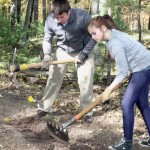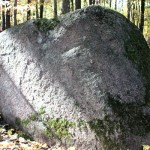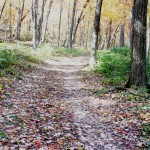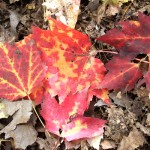Trail rerouted in Hartman Creek State Park
By Greg Seubert
Hartman Creek State Park is usually a pretty quiet place in mid-October.
That wasn’t the case Oct. 13-18, however, as more than 200 volunteers showed up to help build a new 1.5-mile stretch of the Ice Age National Scenic Trail, which passes through the park west of Waupaca.
The Ice Age Trail Alliance’s Mobile Skills Crew Program wrapped up its trail-building schedule for the year. The crew includes volunteers trailed in advanced trail construction and use their knowledge and experience on local projects.
When they weren’t out on the trail, they camped at in the park’s group campground and some slept in tents while nighttime temperatures dropped into the 20s.
Kids help out

Leah Williams, an environmental science and chemistry teacher at Middleton High School near Madison, brought a group of 27 students Oct. 15.
“It’s always great to have them get out in nature,” she said. “We have environmental science and field biology classes, but they learn a lot more when they come out and see the work that’s being done, a lot more than I could ever teach them inside the four walls of a school.
“I think they really notice the difference between where we’re from vs. here,” she added. “They definitely learn to use tools. They haven’t seen these tools before, so that’s a big thing. They learn what it means to do hard work and see what they can accomplish with hard work.”
While some of Williams’ students picked rocks and weeds along the trail route, David Lonsdorf, an Ice Age Trail Alliance Board of Directors member from Verona, also worked on the trail.
The park’s stretch of trail gets a lot of use from campers, while other stretches in northern Wisconsin get little use from the public, he said.
“This is extremely popular because it’s in a state park and Stevens Point, Wausau, Waupaca and Appleton are nearby,” Lonsdorf said. “A lot of people come over here.”
The trail, one of 12 national scenic trails in the United States, runs for more than 1,000 miles from Door County’s Potawatomi State Park to Interstate Park on the Wisconsin-Minnesota border.
“One of the issues with maintaining the trail is getting people to walk on it and prevent nature from taking over,” Lonsdorf said. “Trees fall down and nobody even knows a tree fell down. It could be five to 10 miles from the nearest road, so somebody has to hike in with a chain saw to remove a tree that fell down.”
Luke Kloberdanz, the alliance’s outreach and education manager, contacted Williams three years ago about getting her students involved.
“We primarily help with trail building,” she said. “We also have a connection with the elementary school in Cross Plains, so later on this year, we’ll have another trip where the high schoolers will be mentoring fourth-graders. They’ll hike with the fourth-graders on the Ice Age Trail and get them interested.
“Hopefully, they get future aspirations for being involved as adults in organizations like the Ice Age Trail Alliance,” she said. “A lot of them have ambitions to go on in some type of environmental field. They don’t take Environmental Science until their juniors or seniors, so I’m hoping to find a way to get freshmen and sophomores involved as well.”
She admitted it’s hard to get students interested.
“They’re very scheduled people,” she said. “They’re involved in a lot of stuff, at least in the Middleton-Cross Plains (Area School) District. To ask them to miss a class, especially if it’s a class that requires a lot of homework or a lot of outside time, they have to take the time to make it up. That’s a challenge, but I think they definitely value the experience once they’re here.
“They usually want to go again,” she said. “It’s harder to get them out when they haven’t been out before, but once they’re here and you offer them a trip again, then they’ll be like, ‘Let’s go.’”
One of Williams’ students, senior Charlie Booher, is no stranger to working on trail projects.
“I started working with the Ice Age Trail Alliance as a sophomore in high school,” he said. “I did crew leadership training and have since become a crew leader. I really enjoy the chance to be outside and give back to the trail. I’ve done quite a bit of hiking, but I really want to be able to pay it forward and be able to give back to the trail.”
Booher has worked on Ice Age Trail projects throughout Wisconsin, but this was his first visit to Hartman Creek State Park.
“It looks like it’ll be an excellent stretch of trail,” he said. “The soil type is good, it’s very sustainable and it should be here for a very long time after I am.”
New stretch of trail
Plans for the project have been in the work for years, according to Tim Malzahn, the alliance’s director of trail operations.
“This has been envisioned for about 10 years and actively worked on for the last three years,” he said.
A portion of the Ice Age Trail in the park had to be shut down during the winter because it also served as a groomed ski trail.
“It shut us down in a state park, no less,” Malzahn said. “By being able to reroute the Ice Age Trail from being overlayed with a groomed ski trail, that opens up more recreational uses through four seasons for the public and also creates a much more dynamic and sustainable experience of the landscape itself. We’re not relying on machinery, we’re relying on foot power and human magic. It’ll have a lot more meanders and scenic views and maybe a little deeper connection to the landscape than it did before.”
“The first thing is we have to get permission to build on the land,” Lonsdorf said. “That’s usually relatively easy to do in a state park like this. The trail was already here, we’re just moving it.” Sometimes, we have to ask a private landowner and get a legal easement from them, either sold or donated. Other times, we have to buy the land outright and that can be a several-year process to get the money together to buy it.”
A trail coordinator from the alliance then visits the site and determines where the trail should be located.
“There has to be a certification process where archaeologists and environmentalists have to say it’s safe and permissible to build a trail there: there are no Indian ruins or endangered species,” Lonsdorf said. “The last thing is getting the money together. It’s about $10 or $15,000 a project to have hundreds of people to come out, camp and build a trail. All in all, it takes something like $5,000 to $10,000 a mile to build the Ice Age Trail, which is a staggering amount when you think about how long it is.”
Lonsdorf said it’s important to get kids involved in building and maintaining the trail.
“A lot of the volunteers are 60 or 70 years old,” he said. “We realize that we’re not going to be doing this work in 10 or 15 years, somebody else is going to have to. That’s why we have such a big interest in getting school kids out.”




